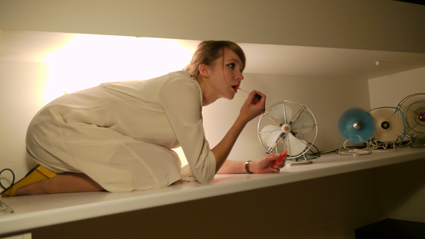Taking flight in a living room
Matthew Lorenzon: Chamber Made Opera, Turbulence

Anneli Bjorasen, Turbulence
photo David Young
Anneli Bjorasen, Turbulence
Despite being the closest any of us will come to experiencing a miracle, air travel is marked by boredom and sustained physical discomfort. With its staging of the explosive relationship between a mother and daughter in an apartment only wide enough for five seats and an airline trolley, Chamber Made Opera’s latest Living Room Opera, Turbulence, explores this banal sort of magic that frames and controls our lives.
Composed by Juliana Hodkinson and featuring the versatile voices of Deborah Kayser and Anneli Bjorasen (in her first Chamber Made Opera role), Turbulence is a ‘first’; several times over for the company in its 25th year.
A row of fans along one wall generates a drafty hum that is amplified into an ambient drone by Jethro Woodward’s ever-understated sound design. The audience take their seats, the front row facing a white wall. I wondered where the performance would take place until Bjorasen began to hum, “pshh” and “khh” like the pneumatics of an aircraft beside me. This opening is the first durational piece I have experienced in a Living Room Opera, providing a welcome contrast to the enchanting kaleidoscopism of previous works. It is also the best environment in which to hear Woodward’s minute control of transparent textures, even in a sound world as saturated as a series of amplified fans. Kayser and Bjorasen’s stereophonic sound effects are a delight, making the central seats the best in the house.
Other sounds endemic to airplanes begin to fill the cabin—a baby crying (live and recorded), 1950s cabin announcements and Bjorasen struggling with a packet of nuts. Bjorasen leans as the plane banks to the right, leaving me in an awkward position for several minutes.
Against this background of whirrs, cries and muffled announcements, the opera continues as a duet between mother (Kayser) and daughter (Bjorasen). The couple share text drawn from academic literature on turbulence, the mother singing graciously against a Pocket Piano synthesiser and the daughter growling impetuously into a vintage microphone. The texts provide an underlying theme of chaos and order, along with the observation that “normal times are when disorder wins.” But the opera is set in the 1950s, shortly after the dawn of commercial passenger aviation. Air travel is now more accessible than ever before and the world is on average half a degree warmer. We are now faced with the task of explaining the workings of the reading lights and seat levers inside the cabin rather than the turbulent air outside: Why in fact do things work the way they do and why is it so difficult to change our orderly progression towards ecological disaster? Faced with the desertion of our future, are we condemned to sing a solo aria, as Kayser does when her daughter walks out on her, reminiscing about a “sea as blue as a baby’s eye?” With the sensitivity and warmth of her voice, which it is worth the ticket price just to hear up close, you could imagine Kayser was lamenting the loss of oceans.
As well as introducing a new performer and a new style of opera to Chamber Made fans, the work is the first Living Room Opera under the new Creative Director Tim Stitz, who made everybody feel welcome before and after the show with a pre-flight talk and post-flight refreshment. Most importantly, Turbulence is the first Living Room Opera to fulfill the company’s claim that the series need not only take place in opulent living rooms of the Eastern suburbs. The space is perfectly suited to the opera, and the opera to the space, revealing the incredible power of chamber opera to unite disparate environments through artistic aims.
Melbourne Fringe, Chamber Made Opera with New Music Network, Turbulence, composer Juliana Hodkinson, libretto Cynthia Troup, sound design Jethro Woodward, performers Deborah Kayser, Anneli Biorasen, a living room, Northcote, Melbourne, 2-3 Nov
RealTime issue #118 Dec-Jan 2013 pg. 42






